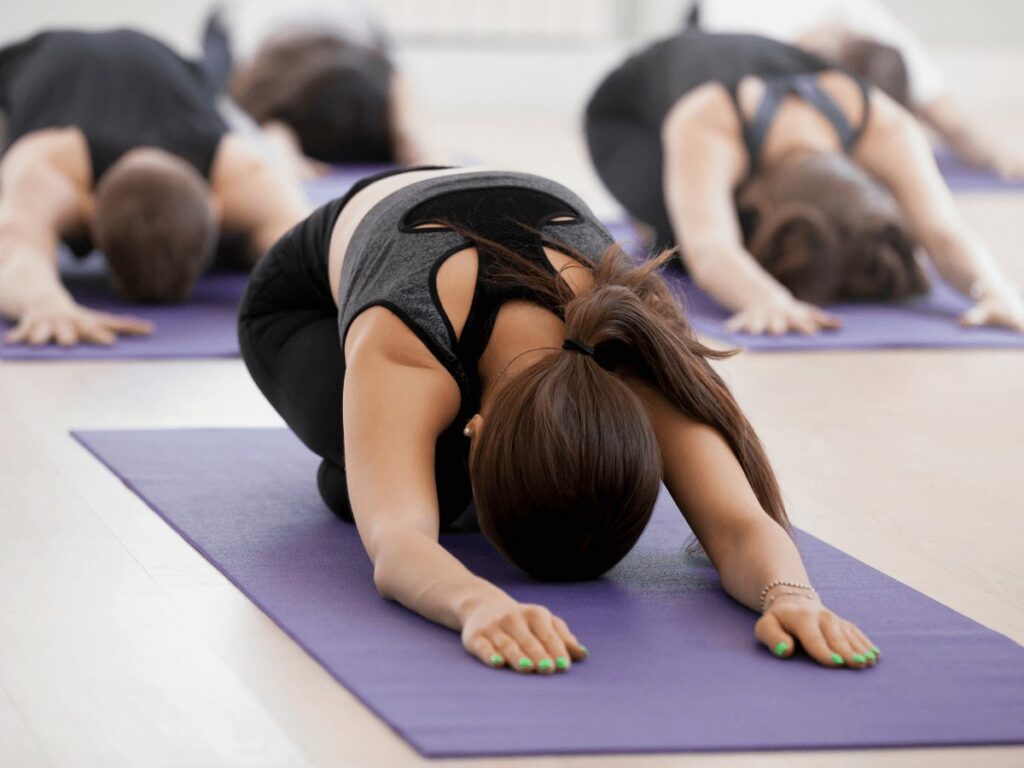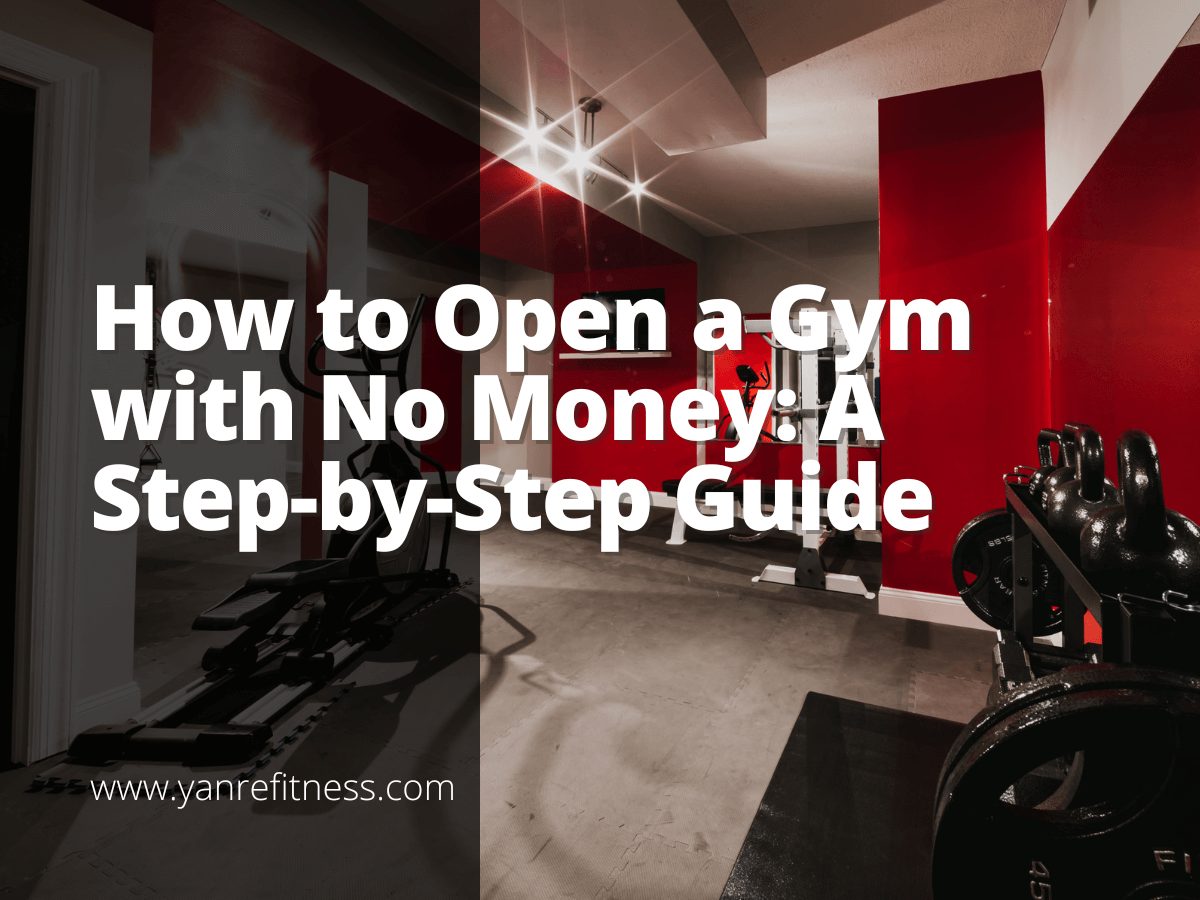Have you ever thought about opening a gym, but financial constraints held you back? The idea of launching a gym with no money may seem far-fetched.
But fear not, we’ve crafted innovative solutions to help you turn your dream gym into reality without a massive investment, including insights on how to open a gym franchise with no money.
Keep reading to discover our step-by-step guide on opening a gym with limited resources.
Table of Contents
- Step 1: Define Your Goals
- Step 2: Identify Your Target Market
- Step 3: Choose Your Location Wisely
- Step 4: Build a Business Plan
- Step 5: Utilize Low-Cost Marketing Strategies
- Step 6: Find Creative Funding Options
- Step 7: Create a Unique Brand Identity
- Step 8: Build Your Gym on a Budget
- Step 9: Launch Your Gym
- Step 10: Continuously Evaluate and Improve
- Conclusion
Step 1: Define Your Goals
Before you start your gym, you need to define your goals. What kind of gym do you want to create? What are your long-term and short-term goals for the gym? Do you want to focus on a specific niche, such as yoga or strength training? Answering these questions will help you create a clear vision for your gym and guide your decision-making process moving forward. Let’s break it down into a few key areas:
Vision and Mission
As a gym expert, I’ve learned from experience that a clear vision and mission statement is crucial when building a gym business. Establishing this foundation has guided my decisions and steered my gym’s growth. Identifying unique selling points has been vital in setting my facility apart from competitors and attracting a loyal clientele.
Short-term and Long-term Goals
Set realistic short-term and long-term goals for your gym. Short-term goals could include reaching a certain number of members, offering specific classes or programs, or achieving a target revenue. Long-term goals might involve expanding your gym, launching a franchise, or becoming a leader in your niche.
Niche Focus
From my experience as a gym expert, I’ve discovered the value of focusing on a niche in my fitness journey. Specializing in a specific area, like strength training, has helped my gym stand out and cultivate a dedicated clientele. Through market research and analyzing competition, I’ve been able to choose a niche that aligns with my passion and expertise, driving my gym’s success.
Financial Objectives
Set clear financial goals for your gym, both in terms of revenue and profit. Calculate your break-even point and establish a plan to achieve sustainable growth. This will help you create a solid financial foundation for your business and make it easier to secure funding or investment.
Community and Networking
Define your goals for building a strong community within your gym and in the wider fitness industry. Networking with other professionals and suppliers can open up opportunities for collaborations, partnerships, and growth. Create a plan for engaging with your local community and the fitness world at large. Examples of building community connections:
- Local Events and Workshops: Participate in and organize events and workshops in your area. This could include hosting fitness challenges, offering free classes for beginners, or holding seminars on health and wellness. These events will not only engage your local community but also give you the chance to network with other fitness professionals and potential partners.
- Industry Conferences and Expos: Attend fitness industry conferences and expos, such as IDEA World, FIBO, or IHRSA. These events are fantastic opportunities to network with like-minded professionals, learn about the latest trends and equipment, and potentially form valuable partnerships with suppliers and other businesses.
- Social Media: Use social media platforms like Instagram, Facebook, and LinkedIn to connect with fellow gym owners, trainers, and fitness influencers. Share valuable content, engage in conversations, and collaborate with other professionals to build a strong online presence and community.
- Local Business Networking Groups: Join local business networking groups or chambers of commerce to meet other entrepreneurs and professionals in your area. These groups often hold regular meetings and events, providing ample opportunities to form valuable connections and share ideas with fellow business owners.
- Charity and Fundraising Events: Get involved with local charity and fundraising events. This is a great way to give back to your community and make connections with other like-minded individuals and organizations. You can sponsor events, provide volunteers, or even organize a charity fitness class or race.
- Collaborate with Other Businesses: Form partnerships with complementary businesses, such as healthy cafes, wellness centers, or physiotherapy clinics. Cross-promotion and collaboration can help you both reach a wider audience, and you’ll be working together to strengthen your local community.

Step 2: Identify Your Target Market
Once you have a clear vision for your gym, it’s important to identify your target market. Who are your ideal customers? What are their fitness goals? What are their demographics? Understanding your target market will help you tailor your gym’s offerings to meet their needs and increase your chances of success. So, let’s break it down into a few essential key points
Demographics
In my journey as a gym expert, I’ve learned the importance of understanding my potential customers’ demographics. By considering factors like age, gender, income, education, and occupation, I’ve gained insights into my target audience’s needs and preferences. This knowledge has enabled me to tailor my gym’s services to cater to their specific interests, ultimately driving the success of my facility.
Fitness Goals and Preferences
Understand the fitness goals and preferences of your target market. Are they looking to lose weight, build muscle, or improve their overall health? Do they prefer group classes, personal training, or self-guided workouts? Identifying these preferences will help you tailor your offerings to meet their needs.
Geographic Location
Consider the location of your gym and the surrounding areas. What types of customers live and work nearby? Is your gym in a residential neighborhood, a busy commercial district, or near a college campus? Understanding the local community will help you determine the best target market for your gym.
Psychographics
As a gym expert with years of experience, I’ve realized the power of understanding the psychographics of my target market. Examining their values, lifestyles, and motivations, like environmental consciousness or work-life balance, has been crucial. This knowledge has guided me in creating a gym environment that resonates with my ideal customers, fostering a strong sense of community and loyalty.
Competitive Analysis
Research your competitors and identify the gaps in the market. What do other gyms in your area offer? Are there any unmet needs or opportunities for differentiation? By understanding your competition, you can position your gym to stand out and attract your target market.
Market Segmentation
Based on the information you’ve gathered, divide your target market into segments. You can segment by demographics, fitness goals, geographic location, or other factors. This will help you create targeted marketing campaigns and develop specialized services for each group.

Step 3: Choose Your Location Wisely
In my experience as a gym expert, I’ve learned the significance of choosing the right gym location.Finding an accessible, visible spot with ample foot traffic was vital, but often pricey. To overcome this, I explored affordable alternatives like sharing spaces with other businesses or renting during off-peak hours, ultimately contributing to my gym’s success. Here are some essential points to keep in mind:
Accessibility
Make sure your gym is easily accessible by public transportation or has ample parking for your members. This will ensure that your clients can conveniently visit your gym, whether they’re coming from work, home, or elsewhere.
Visibility and Foot Traffic
Look for a location that has good visibility and a high amount of foot traffic. This will increase your gym’s exposure and make it more likely that potential members will check it out. Keep an eye out for busy streets, shopping centers, or other high-traffic areas.
Local Demographics
Consider the demographics of the surrounding area. Is your target market well-represented in the neighborhood? Make sure the location you choose aligns with your ideal customer base to maximize your chances of success.
Competition
During my journey as a gym expert, I’ve experienced the importance of understanding the competitive landscape. By thoroughly examining nearby gyms, I discovered ways to differentiate my facility and offer unique services. This approach helped me secure a location where my gym could stand out and address unmet needs in the market, fostering success and growth.
Affordability
Prime locations can be pricey, so explore more affordable options if necessary. This could include sharing a space with another business, renting a space during off-peak hours, or even converting an existing warehouse or industrial space into a gym.
Size and Layout
Make sure the space you choose can accommodate your gym’s needs in terms of size, layout, and facilities. Consider whether there’s enough room for your equipment, classes, locker rooms, and any additional amenities you plan to offer.
Lease Terms and Negotiation
As a gym expert, I’ve faced challenges negotiating lease terms for my gym’s location. To secure the best deal, I consulted with a commercial real estate agent and lawyer. By carefully considering factors like rent, duration, and restrictions, I was able to secure a favorable lease, ultimately contributing to my gym’s success.
Step 4: Build a Business Plan
From my personal experience as a gym expert, I understand the importance of having a solid business plan. It is critical to have a clear roadmap that outlines your objectives and strategies for achieving them. Let’s break down the key points that your plan should include to set your gym up for success:
Executive Summary
Start with a concise summary of your gym’s overall concept, mission, and goals. This should give readers a clear idea of what your gym is all about and what you aim to achieve.
Company Description
Provide an in-depth description of your gym, including its ownership structure, location, facilities, and unique selling points. Make sure to highlight how your gym stands out from the competition.
Market Analysis
Dive into the details of your target market, industry trends, and competitive landscape. Show that you understand the market and have identified opportunities for your gym to succeed.
Marketing and Sales Strategies
Outline your plans for promoting your gym, attracting members, and generating revenue. This could include advertising, social media, partnerships, events, and other marketing tactics. Describe your sales process, such as membership pricing and contract terms.
Operations and Management
Detail your gym’s day-to-day operations and management structure. This includes staffing, equipment maintenance, class schedules, and any other operational aspects. Explain how your gym will be managed, from hiring and training staff to ensuring a safe and clean environment.
Budget and Financial Projections
Present a detailed budget for your gym, including startup costs, ongoing expenses, and projected revenue. Include a break-even analysis and financial projections for the first few years of operation. This will help you demonstrate the financial viability of your gym and attract investors or secure loans, if needed.
Appendices
Through my experience as a gym expert, I’ve learned the value of including supporting documents in my gym’s business plan. Market research data, sample marketing materials, and equipment quotes have all been essential in demonstrating the feasibility and potential profitability of my gym to investors and lenders.

Step 5: Utilize Low-Cost Marketing Strategies
As a gym expert, I understand that marketing can be a significant expense for any gym. However, through my experience, I’ve discovered various low-cost marketing strategies that have proven highly effective. Here are some examples of where you can implement low-cost marketing strategies for your gym:
Social Media
Harness the power of social media platforms like to promote your gym. Share engaging content, such as workout tips, success stories, and behind-the-scenes glimpses of your gym. Make sure to interact with your followers, respond to comments, and share user-generated content. Let me give you an overview of some popular platforms and how they can benefit your gym:
- Instagram: Instagram is an image-based platform that’s perfect for showcasing your gym’s facilities, staff, and members. Post high-quality photos and videos of your gym, workout sessions, and special events. Use Instagram Stories to share behind-the-scenes content or daily updates, and engage with your followers through comments and direct messages.
- Facebook: Facebook allows you to create a dedicated page for your gym, where you can share updates, events, promotions, and photos. It’s also an excellent platform for engaging with your community through comments, likes, and shares. You can even create Facebook Groups for members to discuss fitness goals, share advice, and stay connected.
- Twitter: Twitter is a microblogging platform where you can share quick updates, links to blog posts, and engage with your audience in real-time. Use Twitter to share fitness tips, industry news, and promotional offers. You can also participate in trending conversations or use relevant hashtags to increase your gym’s visibility.
- LinkedIn: LinkedIn is a professional networking platform where you can connect with other gym owners, wholesalers, and distributors. Share informative articles, industry news, or updates about your gym to establish your expertise in the fitness industry.
- YouTube: YouTube is a video-sharing platform that’s perfect for posting workout tutorials, gym tours, and member testimonials. Create a dedicated channel for your gym and regularly upload high-quality videos that provide value to your audience.
Free Trial Memberships
Through my experience as a gym expert, I’ve found that offering free trial memberships or day passes can be an effective marketing strategy for gyms. By providing potential customers with the opportunity to experience the gym’s facilities and services, they are more likely to become paying members.
Community Events
Host community events like fitness challenges, charity workouts, or wellness seminars. These events will not only showcase your gym but also help you connect with your local community and build brand awareness.
Referral Programs
Implement a referral program to reward your current members for bringing in new clients. This could include offering a free month of membership or a discount on their next month’s dues for each successful referral.
Local Partnerships
Collaborate with other local businesses or organizations to cross-promote each other’s services. This could involve partnering with a nearby health food store, sports club, or wellness center to offer joint discounts or special promotions.

Step 6: Find Creative Funding Options
Finding funding for your gym can be challenging, but there are creative options available. You can look into crowdfunding or partnering with local businesses to sponsor your gym. You can also consider offering classes or personal training sessions to generate additional income. Let me break down the key points for you:
Crowdfunding
I remember when I was first starting out in the fitness industry and needed to raise funds for my gym, crowdfunding was a game-changer for me. Launching a crowdfunding campaign allowed me to share my vision with a wider audience and gain support from those who believed in my goals. It was a challenging but rewarding experience that helped me bring my dream to life.
Local Business Sponsorships
Reach out to local businesses and pitch the idea of sponsoring your gym in exchange for brand exposure or other benefits. For example, a health food store might sponsor new equipment, while their logo is displayed prominently in your gym.
Grants and Competitions
I know from personal experience that starting a gym can be a daunting task, especially when it comes to funding. However, there are various ways to secure financing for your gym, including grants, crowdfunding campaigns, and referral programs. Keep an eye out for these opportunities and don’t be afraid to get creative in your approach to financing.
Pre-Sales and Early Bird Offers
Generate funds and build a customer base before your gym even opens by offering pre-sale memberships, early bird discounts, or limited-time promotions. This can help you secure a steady stream of income while creating buzz around your gym.
Offering Classes or Personal Training
Organize fitness classes or personal training sessions in public spaces, community centers, or online before your gym officially opens. This can help generate income while also building brand awareness and attracting future members.
Equipment Leasing
Instead of purchasing expensive equipment upfront, consider leasing options. This can reduce your initial costs and allow you to upgrade to newer equipment more frequently.

Step 7: Create a Unique Brand Identity
According to a 2021 article from Stackla on oberlo.com, authenticity is crucial for brands to connect with their audience. In the current age of authenticity, 88% of consumers consider authenticity an essential factor when deciding which brands to support. Brands must be transparent to establish trust with their audience. Ways on how to create a memorable gym brand:
Design a Logo
I’ve learned the importance of a well-designed logo from my experience in the fitness industry. A visually appealing logo can help your gym stand out and create a strong brand identity. It’s essential to consider your gym’s personality and target audience when creating your logo.
Choose a Color Scheme
Pick a color palette that complements your gym’s overall vibe and personality. For instance, if you’re focusing on a high-energy atmosphere, consider vibrant colors like red or orange. If you’re going for a more relaxed, wellness-oriented space, calming colors like blue or green might be a better fit.
Create a Tagline
I remember when I was opening my own gym, I spent hours brainstorming a tagline that perfectly captured the spirit of my brand. It’s important to choose a tagline that is memorable and communicates your gym’s values or unique selling points. A great tagline can help differentiate your gym from the competition and attract the right customers.
Develop a Consistent Voice
Craft a consistent voice for your brand that reflects your gym’s personality. Is your gym friendly and welcoming, or intense and motivational? Use this voice consistently across all marketing materials, social media, and customer interactions.
Share Your Story
Let people know the story behind your gym – why you started it, what you’re passionate about, and what sets your gym apart. Sharing your story helps build an emotional connection with your audience and makes your brand more relatable.
Incorporate Your Branding
Make sure to incorporate your logo, color scheme, and overall brand identity throughout your gym’s interior design, uniforms, merchandise, and marketing materials. This helps create a cohesive experience for your members and reinforces your brand identity.

Step 8: Build Your Gym on a Budget
When I started my own gym, I faced a tight budget and had to be creative with my purchases. I turned to Yanre Fitness, a gym equipment manufacturer, who offered high-quality equipment at a reasonable price, helping me build my gym without breaking the bank. Here are some examples of how you can build your gym on a budget without sacrificing quality:
Used or Discounted Equipment
As a gym enthusiast and personal trainer, I highly recommend exploring the options of used or discounted gym equipment. When I first started my fitness journey, I was on a tight budget and couldn’t afford to purchase brand new equipment. However, by searching through online marketplaces and gym liquidation sales, I was able to find great deals on high-quality gear that has served me well for years.
DIY Projects
Get creative with DIY projects to save money on gym essentials. For example, you can make your own plyo boxes, sandbags, or even squat racks with a little ingenuity and the right materials.

Low-Cost Classes
I know firsthand how intimidating and expensive the gym can be for some people, as I experienced this myself when I first started my fitness journey. That’s why I offer classes that focus on bodyweight exercises, yoga, and dance as an accessible option. These classes can still provide an excellent workout experience without the need for expensive equipment.

Trade Services
Offer your fitness expertise in exchange for services you need for your gym. For example, you could provide personal training sessions to a contractor who can help with gym renovations or a graphic designer who can create your marketing materials.
Bartering for Equipment
Reach out to local businesses or individuals looking to get rid of their gym equipment. Offer your fitness services in exchange for the equipment you need.
Gradual Upgrades
Start with basic equipment and gradually upgrade as your gym’s membership grows. This allows you to spread the costs over time and invest in new equipment when you can afford it.
Multi-Functional Equipment
Invest in versatile equipment that can be used for multiple exercises, like kettlebells, resistance bands, or TRX suspension trainers. This can help you save money while still providing a diverse range of workout options.
Step 9: Launch Your Gym
Once you have everything in place, it’s time to launch your gym. Offer free trials or discounted memberships to attract new customers. Host an opening event to generate buzz and create a community around your gym. Be sure to have a clear pricing structure and cost to open a gym membership options in place. Let’s dive into some other examples of how you can launch your gym with a bang:
Here’s a table showcasing the offers and discounts for the launching of a gym:
| Offer | Description |
| Membership Discounts | Get special discounts on gym memberships |
| Group Fitness Packages | Purchase group fitness packages at discounted rates |
| Personal Training Offers | Avail discounted rates on personal training sessions |
| Referral Rewards | Refer a friend and get rewarded with exclusive discounts |
| Free Trial | Enjoy a complimentary trial period at the gym |
| Student Discounts | Students can avail special discounts on memberships |
| Senior Citizen Offers | Exclusive offers and discounts for senior citizens |
| Family Packages | Discounted rates for family memberships |
| Corporate Memberships | Special rates and benefits for corporate memberships |
| Early Bird Offers | Sign up early and receive additional discounts |
Community Involvement
Having been in the fitness industry for years, I’ve learned that partnering with local businesses and organizations is a great way to create a strong sense of community around a gym. By offering special deals or hosting joint events, we can encourage local support and foster relationships with other like-minded individuals.
Clear Pricing and Membership Options
Make sure you have a transparent pricing structure and a variety of membership options to suit different needs and budgets. Offer monthly, yearly, or even class-based memberships to cater to a diverse range of customers.
Send Invitations
Reach out to your existing contacts, friends, and family with personalized invitations to your gym’s opening event. Encourage them to bring friends along, and don’t forget to collect contact information for future marketing efforts.
Gather Testimonials
As a gym owner and fitness enthusiast, I know firsthand the impact of positive reviews on a gym’s success. When I first opened my gym, I made it a priority to provide exceptional service and create a welcoming community for my clients. Asking for testimonials and sharing them on my website and social media channels helped me build trust with potential customers and ultimately grow my business.
Step 10: Continuously Evaluate and Improve
As a gym expert, I’ve learned through personal experience that simply opening a gym isn’t enough. It’s essential to continually assess and refine offerings to maintain long-term success. Here are some examples of how you can continuously evaluate and improve your gym:
Customer Feedback
Regularly survey your members or have a suggestion box to collect feedback. Listen to what they have to say and make adjustments based on their input. Happy members are more likely to stick around and recommend your gym to others.

Monitor Trends
Stay informed about industry trends and new workout techniques. Through personal experience, I’ve seen how adding popular workouts such as Zumba, barre, and Pilates to class offerings can help attract and retain members. By providing diverse and engaging workouts, gyms can create a loyal community of members who are excited to come back and achieve their fitness goals.
Upgrade Equipment
Keep an eye on your equipment and team up with Yanre Fitness for timely upgrades. Boost your gym’s experience and showcase your dedication to quality, all while partnering with a manufacturer that gets you.
Staff Development
Encourage your staff to pursue continuing education and attend industry conferences to stay up-to-date on the latest fitness trends and best practices. This will help them provide the best possible service to your members.
Analyze Metrics
Keep track of key performance indicators (KPIs), like member retention rates, new memberships, and class attendance. Use this data to identify areas for improvement and adjust your strategies accordingly.
Community Engagement
Strengthen your gym’s presence in the local community by participating in events or partnering with other businesses. This not only boosts your gym’s reputation but also helps you stay in tune with the needs and interests of your target audience.
Facility Upkeep
As a gym expert, I understand the importance of maintaining a clean and inviting environment for members. In my personal experience, regularly updating facilities such as locker rooms and common areas can significantly improve member satisfaction. By investing in quality equipment and keeping the gym organized, gyms can create a comfortable and welcoming space for members to achieve their fitness goals.
Conclusion
Opening a gym with no money is definitely a challenge, but with creativity, resourcefulness, and determination, it’s possible to achieve. By leveraging low-cost marketing strategies, seeking alternative funding options, and finding ways to cut costs, you can turn your dream of owning a gym into reality.
Ready to take the plunge and start your gym? Yanre Fitness is here to help! We offer high-quality fitness equipment to meet your needs. Contact us today for more product details, our catalog, or a price list. Let our team of experts assist you in building the gym of your dreams.
Related articles:








